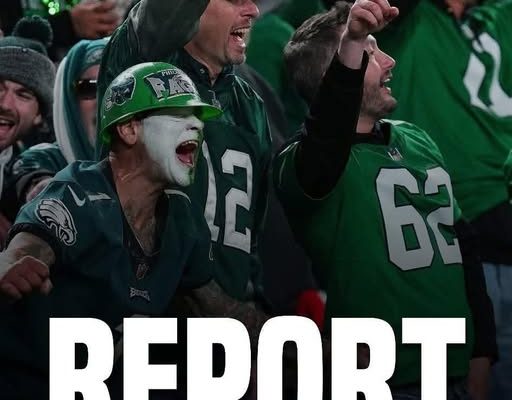The Philadelphia Eagles, a franchise synonymous with passionate fans, hard-nosed football, and a deeply ingrained culture of game-day tradition, have found themselves at the center of a very different kind of gridiron controversy — one involving beer prices at Lincoln Financial Field. Reports have surfaced, most notably via NBC10 Philadelphia, that the team is charging an eye-watering $18.00 for a 16-ounce beer during home games. To put that into perspective, this figure towers well above the NFL average for a similar-sized domestic beer, which generally falls between $10 and $13 depending on the stadium. This staggering price point is not just a marginal uptick; it’s a leap that has triggered immediate and vocal backlash from fans, many of whom have taken to social media to express their outrage, disbelief, and in some cases, outright refusal to pay such a premium.
For many football enthusiasts, beer is not merely a beverage; it’s an integral part of the stadium experience. The ritual of grabbing a cold one while cheering from the stands has been part of NFL culture for decades. While it’s understood that concession prices at professional sports venues have always been higher than at local bars or retail stores, the jump to $18 for a standard pint-sized beer has caught even seasoned stadium-goers off guard. In an era where fans are already grappling with the rising costs of tickets, parking, merchandise, and travel to games, the latest price point feels, to many, like another example of squeezing every last dollar out of the fan base.
The reaction online has been swift and intense. Posts on platforms like X (formerly Twitter), Facebook, and Reddit have amassed hundreds of comments and shares, with many users posting pictures of their beers alongside captions like “$18 for this?!” or sarcastic quips comparing the price to luxury dining experiences. The criticism has not only been about the price itself, but also about the perceived disconnect between the franchise and its loyal supporters. Eagles fans are known for their deep connection to the team, weathering both the highs of the 2017 Super Bowl win and the lows of losing seasons, but this latest development has raised questions about whether that loyalty is being taken for granted.
One key factor in understanding the outrage is the contrast between the Eagles’ pricing and the broader NFL landscape. The Fan Cost Index — a metric often used to measure the overall expense of attending a game — regularly highlights concessions as a major contributor to the total. Even among the most expensive stadiums, an $18 beer stands out. In some cities, fans can still purchase the same 16-ounce pour for as little as $8 or $9, albeit in smaller-market franchises or venues with different operating strategies. By comparison, the Eagles’ pricing structure feels almost like a luxury tax for the privilege of watching football in person.
It’s important to note that the Eagles organization has not issued any official statement explaining or defending the increase. Without a clear justification from the team, speculation has filled the void. Some observers suggest that rising operational costs, supply chain issues, and inflation may be driving prices upward across the board. Others point to the lucrative nature of NFL franchise ownership and question whether such price hikes are truly necessary or simply a means of boosting profit margins. While no one expects stadium prices to match supermarket sales, the jump from the league average to $18 suggests more than just a cost-of-goods adjustment.
Another dimension to consider is the economic climate in Philadelphia itself. Like many metropolitan areas, the city has seen inflation affect the cost of everything from groceries to housing, and discretionary spending on entertainment is increasingly under scrutiny for many households. The Eagles are not merely selling a football game; they are offering an experience, and the perception that the experience is becoming prohibitively expensive could, in the long term, affect attendance and fan satisfaction. While it’s true that the team consistently sells out home games, long-term goodwill is a commodity just as valuable as short-term profits, and eroding that trust could have unforeseen consequences.
Some fans have responded to the pricing news with humor, joking about sneaking flasks into the stadium or tailgating longer to avoid buying beverages inside. Tailgating, after all, has long been a way for fans to enjoy food and drinks at a fraction of stadium prices. Lincoln Financial Field is surrounded by a vibrant tailgate culture, with fans arriving hours before kickoff to grill, play games, and share drinks with fellow supporters. For many, this culture may now take on an even greater significance, as the prospect of buying beer inside becomes less palatable financially.
The economics of stadium concessions, however, are complex. The high prices are not solely a matter of greed; they are tied to operational realities such as staffing, vendor contracts, licensing agreements, and the sheer overhead of running a large-scale venue on game day. Still, it’s difficult for fans to reconcile these realities with the perception that they are being priced out of basic amenities. The optics of an $18 beer in a league that generates billions in revenue annually do little to soften the blow.
In the absence of an official explanation from the Eagles, industry experts have weighed in on possible reasons for the price disparity. One theory is that the team is capitalizing on inelastic demand — the economic principle that certain goods or experiences can be priced higher without significantly affecting sales because consumers have limited alternatives. For many die-hard fans, the idea of attending a game without purchasing at least one beer might feel incomplete, and teams know this. The scarcity of the opportunity — only eight or nine home games per season — further amplifies the willingness of some fans to pay more than they otherwise would.
Still, there’s a limit to how far this principle can be stretched before consumer behavior shifts. If fans increasingly opt out of buying concessions, it could impact the overall atmosphere in the stadium, from the energy in the stands to the revenues of food and beverage vendors. In extreme cases, sustained backlash over pricing could even influence public relations and brand image. Sports teams, after all, are not faceless corporations in the eyes of their supporters; they are cultural institutions. How these institutions balance profitability with accessibility often determines the tenor of their relationship with the community.
It’s also worth noting that beer pricing in sports venues is not just about cost recovery; it’s a strategic decision tied to brand positioning and perceived exclusivity. Some franchises position their concessions as premium offerings, emphasizing craft beer selections, specialty cocktails, or gourmet food pairings. While that can justify higher prices in some contexts, fans expect the quality to match the cost. If the $18 beer at Lincoln Financial Field is a standard domestic pour rather than a high-end craft brew, the disconnect between price and perceived value becomes even more glaring.
In a league as image-conscious as the NFL, the ripple effects of such a pricing controversy can extend beyond the immediate fan base. Media coverage amplifies the story, sparking comparisons to other teams and venues and potentially influencing the broader conversation about the cost of attending live sports. As younger fans, many of whom are more budget-conscious, consider their entertainment options, stories like this can contribute to a narrative that professional sports are increasingly inaccessible to the average person.
From a historical perspective, stadium beer prices have been creeping upward for decades, but the rate of increase has accelerated in recent years. In the 1990s, paying more than $5 for a beer at a game might have been considered high; now, prices in the double digits are commonplace. The Eagles’ $18 mark is, in many ways, the culmination of this trend, pushing the boundary of what fans will tolerate. The danger for the organization lies in becoming the poster child for excessive pricing, a label that can be hard to shake once it sticks.
While it remains to be seen whether the Eagles will address the controversy publicly, there are several potential paths forward. The team could choose to offer more affordable options alongside the premium-priced beer, giving fans a choice without lowering their overall revenue. They could also enhance the value proposition by improving the quality or presentation of the $18 offering, framing it as a premium product rather than just a costly necessity. Alternatively, they might simply ride out the criticism, betting that the uproar will fade as the season progresses and fans focus more on the team’s performance on the field than on the price of concessions.
For now, the $18 beer at Lincoln Financial Field stands as a stark example of the tension between the business of professional sports and the experience of fandom. It forces a conversation not just about beer, but about the broader economics of live entertainment in an age where consumers have more alternatives than ever. Streaming services, high-definition home viewing setups, and dynamic online communities offer fans ways to engage with their favorite teams without setting foot in a stadium. The challenge for the Eagles — and for the NFL as a whole — is to ensure that the in-person experience remains worth the cost, both financially and emotionally.
At its core, this is about more than a beverage. It’s about how fans perceive their role in the ecosystem of professional sports. Are they valued participants in a shared tradition, or are they viewed primarily as revenue streams to be maximized? The answer to that question will shape the future of the fan-team relationship in Philadelphia and beyond. If the Eagles hope to maintain their strong bond with their supporters, they may need to reconsider not only the price of beer, but the message that price sends.
Until then, the $18 pint will remain a talking point in the stands, in the parking lot, and across social media feeds. It’s a reminder that in modern sports, every aspect of the game-day experience — from kickoff to concessions — is part of a larger business strategy. Whether fans accept that reality or push back against it will be a storyline worth watching as the season unfolds. In the meantime, for many in Philadelphia, the choice will be clear: enjoy a cold one at the tailgate and save the $18 for something that feels a little more worth it.



